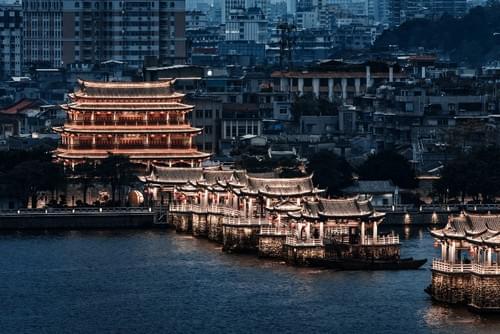
Guangji Bridge: The World’s Earliest ‘Walking Bridge’
Hello, travelers! I'm your TourPal, and today I’m thrilled to take you to a truly unique and fascinating city in Southern China: Chaozhou. Our destination is an ancient marvel that is far from ordinary—it's a living museum of history and engineering: the Guangji Bridge.
In Chaozhou, locals fondly call it the Xiangzi Bridge. If you ask me, "Is a visit to Chaozhou complete without seeing this bridge?" My answer is a firm "No!" The Guangji Bridge is the very soul of the city.
In the esteemed world of Chinese bridges, Guangji Bridge holds a paramount position. It is recognized as one of the Four Ancient Bridges of China (The Four Ancient Bridges of China), alongside the Zhaozhou Bridge in Hebei, the Lugou Bridge in Beijing, and the Luoyang Bridge in Fujian.
But what truly sets Guangji Bridge apart is not just its age, but its astonishing mechanical ingenuity.
The Whispers of History: An 800-Year-Old Legend
The bridge's history dates back to the Southern Song Dynasty (A.D. 1171), making it over 800 years old. Imagine a structure that has quietly spanned the Han River, witnessing countless sunrises and storms, undergoing numerous rebuilds—it is, in itself, a profound history book.
Its construction was an epic, almost mythic undertaking. The Han River is deep and swift, a formidable "natural barrier" in ancient times. To build a long bridge here was a daunting task. The initial simple pontoon bridge was quickly washed away by floods. Determined officials and the people of Chaozhou then spent nearly 300 years, generation after generation, slowly building permanent stone piers from both banks towards the river's center.
Walking here, you feel the spirit of perseverance and the exceptional craftsmanship of the Chaozhou people. This bridge wasn't just built to connect two shores; it's a testament to the wisdom, sweat, and aspirations of countless generations.
An Engineering Marvel: The Floating Section is Real!
Now, let's unveil the most fascinating secret of the Guangji Bridge. It is a bridge that can "transform" or "walk"!
You may have seen the question online: "Is the floating bridge in China real (Is the floating bridge in China real)?" The answer is a resounding "Yes, it is!" And the Guangji Bridge is the most spectacular example, hailed by bridge expert Mao Yisheng as the "world's earliest movable bridge" or "opening-and-closing bridge."
Guangji Bridge is architecturally unique, perfectly blending three types of bridge forms:
Beam Bridge: The sections near both banks are solid stone-slab bridges supported by robust stone piers.
Pontoon Bridge (Floating Bridge): The central section across the river's main channel is made of eighteen ancient boats connected by iron chains.
Pavilion Bridge: Elegant pavilions and towers are built atop the solid stone sections.
The magic lies in the central floating section, vividly described by the phrase: "Eighteen Shuttle Boats and Twenty-Four Pavilions (十八梭船廿四洲)."
The Solid "Stone Islets" (Twenty-Four Pavilions)
The "Twenty-Four Pavilions" refers to the bridge’s original twenty-four main structures—the sturdy stone piers and the exquisite pavilions and towers built upon them.
These structures weren't just for decoration; in ancient times, the 126 rooms and numerous pavilions housed shops, inns, and even government offices. The bridge became a bustling marketplace, earning it the nickname: "One Mile of Bridge, One Mile of Market."
The Dynamic "Shuttle Boats" (Eighteen Shuttle Boats)
This is where the structure comes alive. The "Eighteen Shuttle Boats" form the movable central section.
When Closed: The eighteen wooden boats link up to form a continuous floating pathway, allowing pedestrians to walk across the river.
When Opened: Every afternoon (usually around 5:00 PM, but check local times), the iron chains are unfastened, and the boats are tugged aside, creating a wide channel for large ships to pass through the Han River, making it an essential trade artery.
This genius "movable bridge" design ensured both land traffic and river commerce could thrive, embodying the principle of "rigidity combined with flexibility."
A City on the Bridge: The Chaozhou ‘Ponte Vecchio’
The Guangji Bridge is more than just a crossing; it was a flourishing "Bridge City." The fact that it featured so many shops and pavilions built directly onto its structure gives it a parallel to famous European bridges.
It’s often likened to Florence's Ponte Vecchio, built in 1345, which is famous for the shops built along its span. However, the Guangji Bridge's distinction is profound: it wasn't merely a static marketplace; it was a dynamic one. Its central "commercial district" could be unzipped and zipped back up daily, allowing both merchants and massive cargo ships to coexist—an unparalleled example of sustainable commerce and engineering from the Ming Dynasty era.
Experiencing the Bridge: A Feast for the Eyes
Guangji Bridge’s scenery is so spectacular that it is listed as the first of the "Eight Views of Chaozhou"—"Xiangqiao Spring Tide."
A Painter’s Vision: Stand here in the early morning fog, and you'll witness the "Eighteen Shuttle Boats" seemingly floating on a misty canvas, a truly ethereal sight.
The Golden Hour: At dusk, the setting sun bathes the pavilions in a warm, honey-colored light. When the boats are disconnected, the scene is one of peaceful, dynamic beauty.
The Night Show: Do not miss the nightly light show, dubbed the "Light of Phoenix City." The illuminated pavilions reflect on the Han River, turning the ancient structure into a majestic, glowing spectacle that perfectly merges history with modern illumination.
Visitor's Guide: How to Witness the Magic
To fully appreciate the bridge, you must time your visit right:
Walk the "Walking Bridge": Plan to be there during the time the bridge is "closed" for pedestrian traffic (roughly 10:00 AM to 5:00 PM, check official site for exact times). Stroll along the solid stone sections, admire the architecture of the different pavilions, and feel the unique slight sway as you cross the central pontoon section.
Witness the "Opening": Be on the river bank (the Binhai Promenade is excellent) around 5:00 PM to watch the incredible process of the floating bridge being opened up for the passing ships—a spectacle that showcases ancient engineering at its finest.
Connecting to Culture
The Guangji Bridge stands right outside the East Gate, connecting to the majestic Guangji Gate Tower. Crossing the bridge means entering the heart of Chaozhou’s historical center: Paifang Street (Archway Street).
This street is lined with dozens of ancient memorial archways (Paifang), each telling a story of a virtuous figure from Chaozhou’s history, perfectly complementing the ancient spirit of the bridge.
While you’re exploring, be sure to indulge in the local Chaoshan cuisine—from savory Kueh (rice cakes) to the famous hand-beaten beef balls and local sweet soups. Let your taste buds travel through time alongside your feet!
Final Thoughts
The Guangji Bridge, with its "Eighteen Shuttle Boats and Twenty-Four Pavilions," is a unique masterpiece in the history of world bridge building. It’s not just a relic; it’s a living structure that embodies the ingenuity and perseverance of the Chinese people.
When you stand here, watching the water flow and the bridge come alive, you’ll realize this isn't just a stone and wood structure. It is a timeless poem, a historical connector, and the enduring heart of Chaozhou.
Welcome to Chaozhou, and welcome to the world’s earliest "Walking Bridge"!


